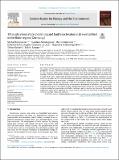3D in situ stress state modelling and fault reactivation risk exemplified in the Ruhr region (Germany)
Abstract
Throughout the 700-yearlong coal exploration period in the Ruhr region, an abundance of geological, geophysical, seismic, and in situ stress data was obtained from the Carboniferous strata. In this study, we take advantage of this unique dataset to develop a static 3D geomechanical model to predict the spatially continuous distribution of undisturbed in situ stress state and evaluate the reactivation risk of major fault zones. Compared to the point-wise stress information, the spatially continuous in situ stress state provides an effective tool for planning subsurface operations and assessing seismic hazards in areas where no stress information is available. The developed model was validated against a comprehensive calibration dataset including results from geophysical logging, borehole deformation, and fault-slip analysis, in situ hydrofracturing measurements, distribution of subsidence, microseismicity, and observations from coal mining activities. Consequently, interpretation and assessment of the model results including their uncertainties, reliability, limitations, and perspectives are discussed. The possible applications of the model approach for seismic hazard prediction and utilization of deep geothermal energy in the Ruhr region are outlined.
Citation
Kruszewski , M , Montegrossi , G , Balcewicz , M , de Los Angeles Gonzalez de Lucio , G , Igbokwe , O , Backers , T & Saenger , E H 2022 , ' 3D in situ stress state modelling and fault reactivation risk exemplified in the Ruhr region (Germany) ' , Geomechanics for Energy and the Environment , vol. 32 , 100386 . https://doi.org/10.1016/j.gete.2022.100386
Publication
Geomechanics for Energy and the Environment
Status
Peer reviewed
ISSN
2352-3808Type
Journal article
Description
This work was carried out in the framework of the 3DRuhrMarie (“FHprofUnt2016”) project, which received funding from the German Federal Ministry of Education and Research (BMBF) and geomecon GmbH.Collections
Items in the St Andrews Research Repository are protected by copyright, with all rights reserved, unless otherwise indicated.

